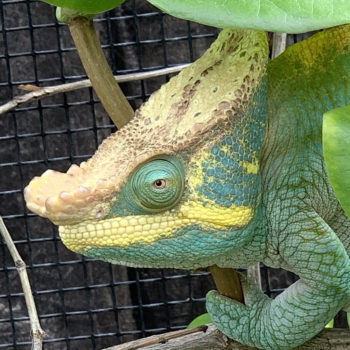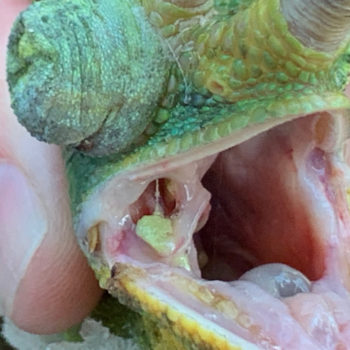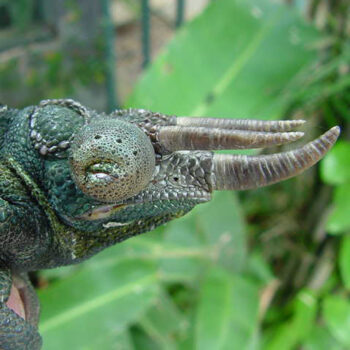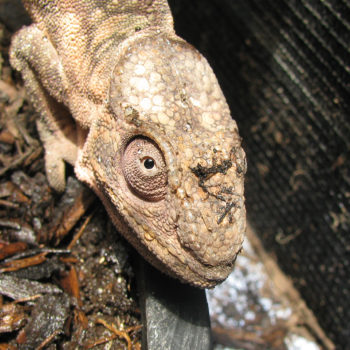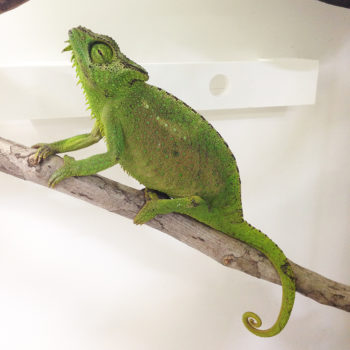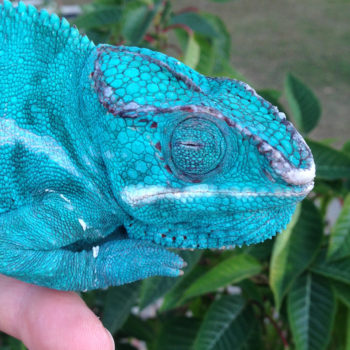Podcast Episode on Eye Issues
Introduction to Chameleon Eyes
The eyes are, perhaps, the most complicated apparatus in the chameleon body and they serve as a rich communication tool as to how the chameleon feels. There is a lot that can go wrong and monitoring the eye every day can give us valuable check up information. Included here is a list of standard eye conditions you may run into and what they mean.
The chameleon eye is an incredible structure. It is a soft turret and highly mobile. The soft tissues can swell up and shrink down. The eyes end up having the characteristic that they reflect the chameleon’s health. So, learning the language of the eye is a valuable skill for every chameleon keeper. Even moreso, because only a small number of conditions we see by a reaction from the eye are actually eye problems. The eye turret is a bellwether for the entire body.
What is most concerning part about seeing your chameleon’s eyes closed during the day is that this is an indication of an advanced condition and immediate action is usually required. But since the treatment for the many different ailments that show themselves through the eye are vastly different you must figure out what the problem really is. Treating the wrong condition is worse than useless, it is life threatening. This is because the real problem has been left to fester. Once the eyes are closed you do not have any extra time to mess with the wrong treatment before the real problem becomes too big to recover from.
There is one notable exception to the rule that healthy chameleons do not close their eyes during the day. Chameleons are very good at learning schedules. And they naturally like to find their place to sleep before the sun sets. So chameleons will turn in before the lights go out. So if your chameleon is healthy and active during the day and then you find him sleeping before the lights go out, that is what is going on and it is normal.
The Healthy Chameleon Eye
The healthy eye is alert and scanning the area at the end of a bulbous turret. When you are looking for your chameleon, the healthy chameleon will have had its eyes locked on you from the moment you stepped in the room. The only time a chameleon will not have its eyes open is when it is sleeping. If your chameleon has its eyes closed during the day this is an immediate warning sign. Chameleons do not nap. And healthy chameleons do not fall asleep on you. This is a sign of an overly stressed or sick chameleon.
The Bulging Chameleon Eye
Unknown Cause
This bulging eye was a mystery as it swelled up to grotesque proportions, but subsided on its own before the vet appointment came up. Perhaps there was a foreign body in the eye? I can only guess. But I am glad I made the vet appointment because there would be no way for me to tell if this was going to resolve itself on its own or if it was going to be life threatening. Make the vet appointment to be safe!
Bacterial Infection
The eye turret is filled with liquid and can get infected. This is quite dramatic and needs to be looked at by a vet with antibiotics administered if it is an infection. Distended eye turrets can be caused by more than just infections, so make sure there is confirmation that that is the problem. Note the green pus in the mouth of the Jackson’s Chameleon above which confirms the nature of this swelling.
Stomatitis to eye infection
This is another eye that was a result of a bacterial infection. If you notice the joint where the lower and upper jaw meet there is the sign of stomatitis (mouth rot) and this infection travelled to the eye. In this case there was only one eye affected because only one side had the infection.
So, let’s start with the bulging eye. Often this happens overnight. Your chameleon suddenly has an eye that looks inflated to a size that is bizarre. It may be sticking out 3/4” from its head with the eye itself functioning, milky, or swollen shut. And the other eye could be completely normal. One possible cause of this grotesque appearance….and yes, when you see it it is grotesque…is a bacterial infection. Either there is an infection in the eye area due to something getting stuck in the eye or else the infection started in the mouth and travelled up the lacrimal-nasal duct that connects the eye and the mouth. A check inside the mouth may reveal pus or swelling. Where ever the infection originates, you need a vet for antibiotics and to clean the area. If you act soon the chameleon can have a full recovery. This is one case where the cause may very well not be connected to husbandry. A mouth infection can occur by biting on an insects wrong or getting a leg spur stuck in the wrong place. Of course, the ability to deal with life’s scrapes and cuts is directly tied to the strength of the immune system which is directly tied to your husbandry, but the feeder insect fighting back is sometimes an injury that can overwhelm the local immune response.
But, because nothing can ever be simple, a bulging eye could be caused by something less serious like an irritation. Swelling can also be less dramatic, especially at the beginning. If you catch it early it could be just a minor size looking like a lump on or around the eye. Or it could be no swelling and the eye is mildly irritated. Or it could be telescoping out. And anything could have happened. Accidentally brushed the eye against a leaf, got a piece of shed stuck in it, rubbed it on one of those fake vines and got a particle in their eye. So many possibilities! The things is that this could resolve itself on its own or, if something is lodged deep, could turn into a festering mess if not removed by a vet with special equipment. I am afraid there are many conditions like this where it could be nothing or it could be serious and, if you are not sure, it is worth getting help diagnosing the problem. Social media is a mixed bag for this. You may run into someone who knows what they are talking about or you may get responses back from people who have no idea what they are talking about. I can go through the roster of likely names and I know who knows their stuff and who is just trying to be important, but if you are new, it is hard to tell because they both speak with the same level of confidence. It doesn’t hurt to get some experienced friends that you know you can trust. I am lucky to have a vet that I can always go to. Dr. Tom Greek at Greek and Associates in Yorba Linda, CA has been my vet for the last 25 or so years. He is deeply experienced and we have gone through an amazing number of chameleon adventures together. I’d like to think I had a small part in helping his day be a little unusual over the years.
The Sunken Chameleon Eye
Physical Exertion
Sometimes the eye turrets will sink in as a sign of exhaustion or dehydration. In this case, the female panther chameleon spent great effort to lay eggs and is exhausted and probably dehydrated. In a case like this you see the sunken eyes, but they are still alert. This means you have a non-life threatening condition and the chameleon just needs some water, food, and rest. This is the time for a spa day.
Internal distress
If the eyes are sunken in and are not alert and responsive then it could be a sign of internal distress. In this picture the female is egg bound and is having trouble getting the eggs out. Her body is saying to get them out, but something it blocking the process. This is a life threatening situation. Other forms of distress are parasite loads which have grown beyond what the chameleon’s body can handle, organ stress, or infections. Most things that are hurting the chameleon internally will show up in the eyes.
Next we come to the sunken eye. A sunken eye could be the result of something going on inside. We see sunken eyes in the advanced stages of sickness. Although there will be some cases where a chameleon under stress will suck in their eyes as a sort of protective move, we should never let a situation get to the point that the eyes are sunken in. I have seen it in the later stages of an infection which could not be controlled. It was not pretty and I hope to never see it again. The common assumption to sunken eyes is that it is because of dehydration. It can be, but we don’t want to assume every case of this is due to dehydration. The problem is that if we treat for dehydration and it is something else that we may pass the recovery window treating for the wrong thing.
Sunken eyes may be the first thing that trips you of that something is wrong. But, unless it is a physical trauma, vitamin deficiency, or emotional overload, there would be other symptoms that would have predated the sunken eyes. If respiratory infection there will be breathing difficulties If distress due to parasitic infection then a fecal would give clues. Fungal infection, dehydration…these all have other symptoms before the eyes sink in. It is every chameleon keeper’s goal to get to the level of sensitivity that they can pick out the symptoms and take care of the problem before it gets to eyes sinking in.
The Closed Chameleon Eye
The most common reason a chameleon will close their eyes during the day is because of an internal infection whether it be bacterial, parasitic, viral, fungal or whatever else nature can throw at us. This is where the internal balance is off and the chameleon feels sick. The most common manifestation of this is in the form of a respiratory infection. This is where there is a bacterial bloom in the lungs. And where the bacteria is, the lungs are not absorbing oxygen. So we have the body shutting down to divert resources to the immune system and we have the lung function being compromised at the same time. So the chameleon really doesn’t feel like doing much at all. They are exhausted from fighting the infection and they can’t breathe properly. This is why, during a respiratory infection, that the chameleon will stuck their nose up. They are straightening the esophagus to get a more direct path for air. And then they will gape and mouth breath to try and get more air in. And this is important to know. By time you see the nose in the air or gaping the infection is well started and is going strong. By time the eyes start closing because of the effort you know you are on the last legs and that death is in the future. The more advanced the infection the lower the chances of recovery. So this is why it is not overreacting to go into high alert when you start seeing signs of respiratory infection. When the symptoms are small is when it will most respond to treatment. This leads chameleon keepers to have a gut feel capability and, when attenuated, can diagnose problems before the vet can detect them.
And this isn’t a slam on the vet. Remember that a chameleon will do its best to show it is healthy and not an easy target. So when you bring them to the vet they are riled up and showing their most fearsome look. So the vet may not be able to see what you observe at home. And that is actually a good sign that your chameleon is not too far gone. If your chameleon can put on a good face for the vet there is hope. If the Chameleon cannot muster up even an attempt at defense after a trip to the vet and a handling then you know it is dire. Pro tip: When you need to take them into the vet for something like eyes closed, take a video of the chameleon doing what concerns you before you disturb them to put them into the carry box. That way the vet can see what goes on when the chameleon is not putting up a show of strength.
Diagnosing a respiratory infection is easy because the additional symptoms are unmistakeable. But it starts to get a little murky when the internal issue is something else. A heavy parasitic infection will make your chameleon want to hunker down in one place, not move, and keep their eyes closed. Any other internal distress will make them do the same thing. And here is the reason why having a vet’s help is desired. You use antibiotics if it is a bacterial infection, anti-parasitics if it is a parasitic infection – and even for these the medicine has to be selected for the type of parasite. Fungal infections need a different medicine than viral infections. And a severely impacted chameleon won’t have much use for any of those medicines. Some of these ailments don’t have many external clues. But here are some items to look for.
A bacterial infection will show some swelling somewhere. The problem is that the swelling may not be obvious. You can try to get the mouth open and check there. The mouth and the lungs are the two areas most in contact with bacteria. The lungs from breathing and the mouth from eating. Jackson’s Chameleons have the added Temporal Gland which can get infected. This, at least, is an obvious swelling at the joint of the mouth.
Parasitic infections can be determined by a fecal test that your vet can run. They will probably require you to bring the chameleon in before they prescribe medicine (to make sure they give you the right dosage), but they should be able to run the fecal test with just a fecal sample brought in. You get a sample by putting the freshest poop possible in a plastic ziplock bag and getting that to the vet asap. You can put it in the refrigerator to store it for a little bit, but the longer it is the more some of the protozoa may die. Drying out is the biggest damage so seal it up good. Gastrointestinal distress from parasites can also show it self in poorly formed poop.
Viral infections are difficult. Your chameleon will start to waste away and not respond to any of the remedies, including antibiotics. Vets can test for certain viruses to confirm it is a viral infection. But a negative in that test only confirms it is not a virus we are testing for. We are lucky that our chameleons do not often have viral infections. But when they do it can be devastating.
You may have gotten lost in that entire discussion about infections and that is because it is not a simple thing to work with. Hopefully, your vet has experience with reptiles. If not then you will have to do some observation yourself.
Vitamin A Deficiency
Closed eyes are a major warning sign of something wrong. Unfortunately, different causes can have the same outward effective. One cause of chameleons keeping their eye closed is a vitamin A efficiency. This shows itself by the chameleon having difficulty opening its eye or using it. The chameleons shown here have vitamin A deficiency. The solution, if it is a deficiency, is to give them vitamin A to replenish their vitamin stores.
The next common reason for chameleons to be found with eyes closed is due to vitamin A deficiency. Without proper levels of vitamin A the eyes crust over. And, no, that isn’t the scientific description. But you will notice that the chameleon has a hard time keeping their eyes open. In the beginning they will look like the eye lids are closed, but they will be able to open them to eat, but over a couple weeks it will get to the point where they can’t open the eyes even to eat. It may affect one eye more than the others, but it is common for both eyes to be affected together.
Vitamin a deficiency can be reversed when you provide vitamin A in the diet. A vet can give an emergency dose of Vitamin A and you can add it in the diet.
You can avoid this by using a multivitamin which includes preformed vitamin A on a regular basis as designated by the care sheet for your particular species. I like using a multivitamin which has about 100,000 IUs/lb or less every other week for panthers or veiled and once a month for Jackson’s. But you need to check the ingredients list and make sure it has vitamin A and not just beta carotene. It appears, by one study, that chameleons may not convert beta carotene. The story behind that is that vitamin A is mostly found in vertebrates, while invertebrates like insects don’t have much. But insects can carry carotenoids which they get from eating plants and some animals can turn carotenoids into vitamin A. Beta Carotene is a carotenoid. So this explains why Dr. Gary Ferguson’s experiment that suggested that panther chameleons do not convert beta carotene threw us all for a loop. That said, there is still much to be figured out. If they do not convert beta carotene, how do they get vitamin A? Smaller chameleons like carpet chameleons and pygmy chameleons don’t have many vertebrates to pick off. Do they convert other carotenoids? Why is it that breeders can raise generations of chameleons without supplementing vitamin A and have no issues with closed eyes? So, we still have many questions without answers on this one. Dr. Ferguson looked at the composition of the egg and found beta carotene, other carotenoids, and vitamin A. So there is a lot to sort out.
The safest approach is to just include a supplement with vitamin A once or twice a month and, if you end up with a chameleon with vitamin A deficiency to get a concentrated dose from the vet and then get your chameleon on that multivitamin.
Emotional Distress
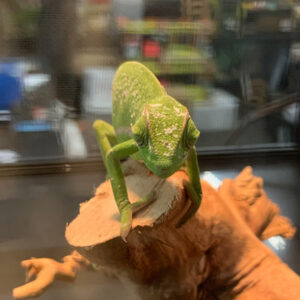
Chameleons will close their eyes when they reach the highest stages of stress. This is when they realize there is no escape from a predator and they are resigned to be eaten. Unfortunately, this is what is happening when they are napping on your hand. When humans, dogs, or cats nap with each other it is a sign of bonding and trust and family. Chameleons are intelligent, and have complex interactions, but they do not have families and do not develop family group intimacies. They do not have the same emotional needs as we do and to force them to engage in our emotional culture can push them to dangerous stress levels. Unfortunately, when a chameleon is napping on your hand it is not trust, but actually, a sign that they have been stressed beyond the breaking point and have given up on life.
This is one of the hardest truths to accept because we humans want them to love and trust us like families do.
While there are a small percentage of chameleons that truly have no fear of humans and will readily walk right out onto your hand, the majority of chameleons are shy and nervous around larger animals. If we truly love our chameleons we will learn their language and respect what they are as beautiful and not try to make them human.
The keys to avoiding emotional stress are
- House chameleon individually. Do NOT keep chameleons together in the same cage!
- Limit your handling of your chameleon. Occasional handling is not n issue, but extended sessions can push your chameleon to dangerous stress levels. How much depends on your chameleon’s individual temperament.
Debris in the Eye
And, finally, let’s talk about random debris. Things can get in your chameleon’s eye. This can be things coming off of fake vines when the chameleon rubs their eye against the vine. And, yes, chameleons will rub their eyes against the branch when they have an itch or discomfort. If something gets in those eye turrets it can be uncomfortable and, eventually, cause an infection in the eye. So, not a whole lot of fun there. When something gets in the eye turret there will be irritation. The chameleon may rub its eye against the branches trying to alleviate the discomfort. The eye may swell up a little or a lot depending on what is in there and where it is. This is another situation where they could easily dislodge it themselves and all is well or else it becomes an infection and a mess that requires veterinary assistance. The thing is the less experienced you are the less able you are to tell the difference. Heck, I couldn’t even give you a check list of things to look for to run down. Every situation is different. Personally, I go straight to the vet who has that fancy scope. I don’t like waiting when it is something that could get worse. Because once it gets worse the chance of recovery decrease. And the absolute best news I could ever hear from my vet was that I overreacted. I like going home with nothing wrong. But seriously, what I do go home with is knowing for sure what is going on and what actions, if any, I need to take to ensure the health of my chameleon.
Avoiding Eye Issues

The best way to deal with eye issues in a chameleon is to prevent them in the first place. Most eye issues are actually health issues and there are three main health strengthening strategies.
Husbandry – By providing the right temperature and humidity cycles in the right size cage the chameleon’s body is in ideal conditions and there is no stress involved in just day to day living.
Nutrition – A chameleon’s immune system and internal working order is maintained in top working shape by feeding your feeder insects well, maintaining a good supplementation schedule with some vitamin A, access to proper levels of UVB light, and a good hydration cycle.
Emotional well being – To keep chronic stress away from your chameleon, make sure their cage has an area where they can hide from view, keep them individually – one chameleon per cage, and respect their level of shyness and acceptance, or fear of, handling.
The most common reason why chameleons end up in the vet’s office is because of husbandry issues. If you dig deep into the care sheet for your species and do not cut corners on either the chameleon or the equipment there is no reason why you can’t avoid ever having to go to the vet over your chameleon’s long life.
Treatment
The chameleon eye is a great way of letting us know that something is wrong with our chameleon. But it takes some more digging to figure out exactly what the problem is. And, dig we must. We must look for other clues to help us come to the correct diagnosis because each condition is treated with completely different medicines or procedures! This is why a good exotics vet with reptile experience is indispensable!


